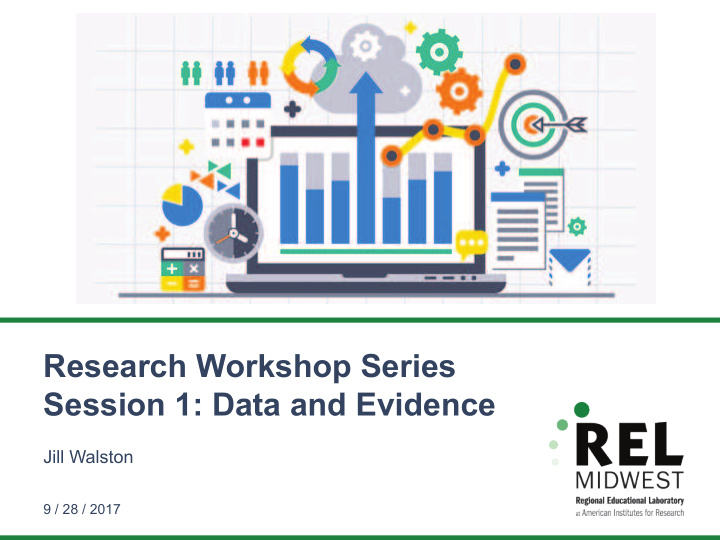



Research Workshop Series Session 1: Data and Evidence Jill Walston 9 / 28 / 2017
Agenda 1. What is REL Midwest? 2. Overview of training series. 3. Data collection methods. 4. Types of research and levels of evidence. Continuous improvement model. 5. 6. Session close and evaluation.
Regional Educational Laboratories
REL Midwest States
Workshop Series 2017 September 28 Data, Research, and Evidence October 24 Survey Development and Administration November 15 Interviews and Focus Groups 2018 January 17 Observations and Rubric Development March 8 Data Analysis April 25 Communicating Research Findings
Today’s Goals 1. Discuss appropriate uses of different kinds of data collection methods. 2. Present overview of different types of research and levels of evidence. 3. Discuss how DPI uses data and evidence in the context of a continuous improvement cycle.
Data Collection Methods
Surveys are appropriate data collection tools for many purposes …
A survey can produce quantitative descriptions of the characteristics and attributes of a population.
Think about how survey results will be used.
Other Data Collection Options Interviews? Focus groups? Observations? Access existing data?
Focus Groups Participant interaction can provide a rich description of views and experiences.
Focus Groups Help formulate and pretest survey items. Explore quantitative survey findings. Use as a stand-alone data collection method.
When to Use Focus Groups Instead of a Survey
Focus Groups
Interviews are suitable for investigating complex topics without well- defined research questions.
Observations 1. Planning for a Survey
Rubrics No Partial Full implementation implementation implementation 1. Blank Blank Blank 2. Blank Blank Blank 3. Blank Blank Blank 4. Blank Blank Blank
Analyzing Existing Data
Activity: Handout 1 Work in your group to select a data collection method (or combination of methods) that would be appropriate for each data need scenario.
Research and Levels of Evidence
Different Types of Research Contribute to Our Knowledge in Different Ways.
Let’s say you are interested in early elementary programs aimed at advancing students’ digital literacy skills.
Foundational, Exploratory Research • Supports development of a theory. • Describes what digital literacy means for K-3 children. Determines how K-3 children interact with and understand technology and digital devices. • Establishes initial connections to outcomes of interest. • Examines what activities and experiences relate to higher levels of digital literacy.
Design and Development Research • Develops interventions or strategies based on theory. • Designs a program to integrate digital literacy activities into K-3 curriculum. Develops measures to track implementation. • Tests components of intervention to inform the development process. • Examines data from teachers about implementation challenges. Measures students’ skill development. Refines components of program.
Impact Research • Determines if a well-defined program achieves its intended outcome and estimates impact. • Conducts a large scale study comparing digital literacy skills (using a reliable and valid assessment) for students in a randomly- selected group of schools implementing the program and those in a group of schools that are not.
Questions to Consider about a Program or Intervention • What kind of research has been done? • Does the research show positive effects? If so, for which students and under what conditions? • How large is the effect compared with other programs? • How strong is the evidence?
Levels of Evidence in the Every Student Succeeds Act (ESSA) Tier 1 Strong Evidence • at least one well- designed and well- implemented experimental study • significant favorable outcomes • large sample • similar types of students and settings as intended application
Levels of Evidence in the Every Student Succeeds Act (ESSA) Tier 1 Tier 2 Strong Evidence Moderate Evidence • at least one well- • at least one well- designed and well- designed and well- implemented implemented quasi- experimental study experimental study • significant favorable Text. • significant favorable outcomes outcomes • large sample • large sample • similar types of • similar types of students and students or settings settings as intended as intended application application
Levels of Evidence in the Every Student Succeeds Act (ESSA) Tier 1 Tier 2 Tier 3 Strong Evidence Moderate Evidence Promising Evidence • at least one well- • at least one well- • at least one well- designed and well- designed and well- designed and well- implemented implemented implemented quasi- correlational experimental study experimental study study • significant favorable Text. • significant favorable • significant outcomes outcomes favorable • large sample • large sample outcomes • similar types of • similar types of students and students and settings as intended settings as intended application application
Levels of Evidence in the Every Student Succeeds Act (ESSA) Tier 4 Demonstrates a Rationale • includes a well-specified logic model • efforts to study the effects are planned or underway
Where Can We Find Information about Evidence-based Practices and Programs? • What Works Clearinghouse https://whatworks.ed.gov • Best Evidence Encyclopedia http://www.bestevidence.org/
Continuous Improvement Cycle
Activity Work in your group to identify examples of where your division is currently using locally collected data and/or evidence- based research to inform different elements of the continuous improvement cycle.
Jill Walston jwalston@air.org
Recommend
More recommend